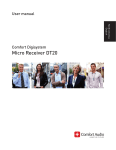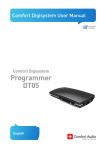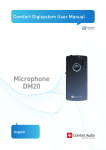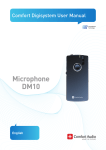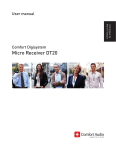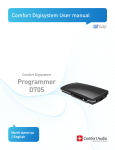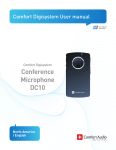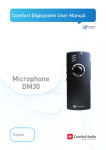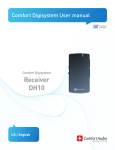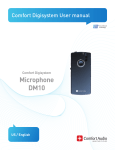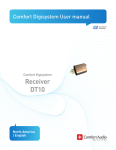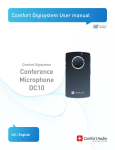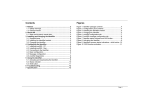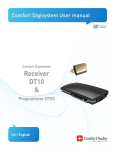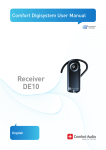Download Micro Receiver DT20
Transcript
User manual English Comfort Digisystem Micro Receiver DT20 English User Manual Table of Contents Page Introduction Comfort Digisystem 3 Presentation of the Micro Receiver DT20 3 Overview - Micro Receiver DT20 4 Check the hearing instrument’s input 5 Getting started 7 Acoustic indication, sound signals 8 Modes in the Micro Receiver DT20 8 Output for user with different input types and programs in the hearing instrument 9 Pairing 12 Trouble shooting Service and warranty 14 Technical data 15 Important safety instructions 16 2 Micro Receiver DT20 15 Introduction to the Comfort Digisystem Thank you for choosing Comfort Digisystem. Our products are easy to use and give you crystal clear sound. Before using the product, please read this manual carefully. The Comfort Digisystem products feature SecureStream Technology – a unique, patented digital technology allowing eavesdrop-secure radio transfer in real time. Comfort Digisystem Micro Receiver DT20 — the world’s smallest digital mini receiver The Comfort Digisystem Micro Receiver DT20 is a digital mini receiver that you can easily connect to any hearing aid with a standard three-pin Europlug audio shoe. The receiver weighs 1,1 gram and is powered by the hearing instrument’s battery. To minimize energy consumption, the mini receiver is equipped with an optional auto-sleep feature. Together with existing microphones and receivers in the Comfort Digisystem assortment, the Micro Receiver DT20 provides clear speech perception. The optional professional tool Programmer DT20 can be used to configure the Micro Receiver DT20. The Programmer DT20 also makes it easy to test the Micro Receiver DT20 with or without a hearing instrument. Micro Receiver DT20 3 Overview - Micro Receiver DT20 Europlug For connecting to the audio shoe on a hearing instrument or to the socket on the Programmer DT20. 4 Push-button For toggling between different listening modes and activating pairing mode. Micro Receiver DT20 Check the hearing instrument’s input To be able to use the Micro Receiver DT20, check if — and how — the hearing instrument supports the use of a mini receiver: 1. The hearing instrument must be equipped with an audio shoe with a powered Europlug socket made for mini receiver use. This connects the Micro Receiver DT20 to the hearing instrument and also supplies the DT20 with power from the hearing instrument’s battery. The received audio signal will then be transferred from the Micro Receiver DT20 to the hearing instrument through the audio shoe. 2a. If the hearing instrument is equipped with a Programmable DAI input (DPAI), programming of the hearing instrument might be necessary (check with audiologist or hearing instrument manufacturer). In this case the pushbutton on the Micro Receiver DT20 cannot switch between the R and R+M modes. This is instead done by using different listening programs in the hearing instrument. DT20 Europlug TIP! The volume of the Micro Receiver DT20’s R and R+M mode can be set individually by using the Programmer DT20. This makes it possible to use the push-button as a simple volume control in combination with a hearing instrument with Programmable DAI input (DPAI). Micro Receiver DT20 5 2b. If the hearing instrument is equipped with a DAI input (check with audiologist or hearing instrument manufacturer), no programming of the hearing instrument is necessary. The Micro Receiver DT20 works with the Microphone (M) listening program on your hearing instrument. By setting up the Micro Receiver DT20 with the Programmer DT20, the push-button on the Micro Receiver DT20 can be used to select the listening mode: Radio only (R mode) or Radio + Hearing instrument microphone (R+M mode). DT20 6 Europlug Micro Receiver DT20 Getting started Connect the Micro Receiver DT20 to the audio shoe on the hearing instrument. Check that the audio shoe is connected to the hearing instrument according to the manufacturer’s instructions. Make sure that the Micro Receiver DT20 is fitted in the correct manner and push the Euro-plug completely into the socket of the audio shoe. OK! NOT OK! The Micro Receiver DT20 is powered by the hearing instrument’s battery. Make sure that the battery is fresh. If you are unsure, replace the battery. The Micro Receiver DT20 will start automatically when it’s connected to the hearing instrument. Briefly press the push-button on the Micro Receiver DT20 to turn it on or off again. Micro Receiver DT20 7 Acoustic indication, sound signals The following is a description of the acoustic indications (sound signals). The sound signals consist of various combinations of two different tones: one high pitch tone (1000 Hz) and one low pitch tone (500 Hz), and two different tone lengths. Action:Sound signal:Indicate this: • Button pressed Short high pitch Selecting mode briefly or turning on Button pressed briefly •• Short high pitch x 2 — Turning off + long low pitch Button pressed 2 sec. Short low pitch + short high pitch Pairing Short high pitch x 2 Pairing Long high pitch + long low pitch • • Pairing mode •• Successful pairing — — Pairing failed Listening modes in the Micro Receiver DT20 The available listening modes in the Micro Receiver DT20 can be setup in different configurations: R Default setting R+M Setup with Programmer DT20 is necessary R and R+M Setup with Programmer DT20 is necessary The Programmer DT20 is used to configure and enable or disable different listening modes in the Micro Receiver DT20. The push-button on the Micro Receiver DT20 is used to toggle between the activated listening modes. It is also possible to disable the push-button completely. 8 Micro Receiver DT20 Output for user with different input types and programs in the hearing instrument Different hearing instrument electrical input types and available programs in the hearing instrument will result in different output for the user. Output for the user is shown in the white sections of the charts below. Micro Receiver DT20 with R mode enabled (default setting) The chart below shows the output (what the user can hear) when Micro Receiver DT20 listening mode R is enabled in combination with different input types and programs in the HI. When pressing the push button on the Micro Receiver DT20, the listening mode is shifted in the following sequence: Micro Receiver DT20 push-button Off R mode Off Radio only Off Radio + HI microphone Off Radio only Hearing instrument: DAI input Programmable DAI input DAI + M program Programmable DAI input DAI program only Micro Receiver DT20 9 Micro Receiver DT20 with R+M mode enabled and R mode disabled The chart below shows the output (what the user can hear) when Micro Receiver DT20 listening mode R+M is enabled, in combination with different input types and programs in the HI. When pressing the push-button on the Micro Receiver DT20, the listening mode is shifted in the following sequence: Micro Receiver DT20 push-button Off R+M mode Off Radio + HI microphone Off Radio + HI microphone Off Radio only Hearing instrument: DAI input Programmable DAI input DAI + M program Programmable DAI input DAI program only 10 Micro Receiver DT20 Micro Receiver DT20 with both R and R+M modes enabled The chart below shows the output (what the user can hear) when Micro Receiver DT20 listening modes R and R+M both are enabled, in combination with different input types and programs in the HI. When pressing the push-button on the Micro Receiver DT20, the listening mode is shifted in the following sequence: Micro Receiver DT20 push-button Off R mode R+M mode Off Radio only Radio + HI microphone Off Radio + HI microphone * Radio + HI microphone * Off Radio only * Radio only * Hearing instrument: DAI input Programmable DAI input DAI + M program Programmable DAI input DAI program only * When using this setup in combination with Programmable DAI input (DPAI), the level of the two modes (R+M and R) can be programmed individually to serve as a volume control. Note! Difference in volume can occur When using a hearing aid with Programmable DAI input (DPAI) and having both R and R+M modes in the Micro Receiver DT20 enabled there can be a difference in volume between the R and R+M modes even if the Micro Receiver DT20 has been programmed with identical output levels for the two modes. The reason for this difference is that the output level in the Micro Receiver DT20 is affected by the input impedance of the hearing instrument. The difference in output level can vary between different hearing instruments usually the output level will be slightly higher in the R+M mode. An adjustment might be done with the Programmer DT20 in order to meet the users requirements. Micro Receiver DT20 11 Pairing The Micro Receiver DT20 can receive but not transmit pairing information. To pair the Micro Receiver DT20 with your Comfort Digisystem transmitter the Micro Receiver DT20 must be connected either to your hearing instrument or to the Programmer DT20. Press the push-button on the Micro Receiver DT20 for 2 seconds to activate pairing mode. When pairing mode is activated, you receive an acoustic indication: • • Send the pairing information within 15 seconds. To interrupt pairing mode, briefly press the push-button. Example 1: Pairing a Micro Receiver DT20 into an existing Comfort Digisystem consisting of one Conference Microphone DC20 and one Receiver DH10: 1. 2. 3. 4. 5. Connect the Micro Receiver DT20 to the hearing instrument’s audio shoe according to the instructions. Initiate pairing mode in the DT20 by pressing the push-buttons for 2 seconds. Acoustic indication: • • Start the Conference Microphone DC20. Rapidly press the pairing button on the DC20 twice. The display on the DC20 responds with the text Sending info. The Micro Receiver DT20 confirms successful •• pairing with an acoustic indication: Example 2: Make a new eavesdrop secure configuration with one Microphone DM90 and two hearing instruments with Micro Receiver DT20s: 1. 2. 3. 4. 12 Connect the Micro Receiver DT20s to the hearing instrument’s audio shoes according to the instructions. Activate pairing mode in the two DT20’s by pressing the push-buttons for 2 seconds. Acoustic indication: • • Start the Microphone DM90 and open the menu. Select Communication/ Pairing/New code key and answer Yes to the question of whether you want to create a new code key and transmit it. The Micro Receiver DT20s confirm successful •• pairing with an acoustic indication: Micro Receiver DT20 Example 3: Make a new eavesdrop secure configuration with one Microphone DM90 and two Micro Receiver DT20s using the Programmer DT20: 1. Put one of the Micro Receiver DT20s into the Programmer DT20. 2. Start the Programmer DT20 and connect headphones or a neck loop to be able to listen. 3. Activate pairing mode for the DT20 by pressing the push-button for 2 seconds. In the headphones/neckloop you receive an acoustic indication: • • 4. Start the Microphone DM90 and open the menu. Select Communication/ Pairing/New code key and answer Yes to the question of whether you want to create a new code key and transmit it. 5. The Micro Receiver DT20 confirms successful pairing with an acoustic indication: • • 6. Remove the paired DT20 and connect the other DT20 into the Programmer DT20. 7. Activate pairing mode on the DT20 by pressing the push-button for 2 seconds. In the headphones/neckloop you receive an acoustic indication: • • 8. Open the menu on the DM90 and select Communication/Pairing/Send info. 9. The Micro Receiver DT20 confirms successful •• pairing with an acoustic indication: Micro Receiver DT20 13 Trouble shooting The receiver does not start 1. Check that the correct listening program is selected on the hearing instrument. 2. Make sure the Micro Receiver DT20 is correctly connected to the hearing instrument’s audio shoe. Also check the connection between the audio shoe and the hearing instrument. 3. Make sure all connecting surfaces are clean. 4. Check/replace the hearing instrument’s battery. 5. Remember to press the push-button briefly to switch the DT20 on. Poor speech intelligibility The distance between the transmitter and the receiver may be too long. The range is around 25 meters. The distance between the microphone and the talking person may also be too long; move the microphone closer to the talking person. Try changing the channel/environment. Poor range and interference In some environments, such as in buildings with a lot of concrete, iron or sheer metal structures, the range may be reduced. There may also be electronic equipment nearby causing interference. Change the channel. No sound Check that the transmitter and the receiver are set to the same channel. Loud hissing noise Check that the Comfort Digisystem units you are using are paired together. 14 Micro Receiver DT20 Service and warranty Comfort Audio AB accords a limited warranty for two years as of the date of delivery. This covers all defects of manufacture and materials. For accessories the warranty period is 90 days as of the date of delivery. Local agreements or regulations may exist. Defects caused by careless handling or intervention inside the product or its accessories are not covered by the warranty. Technical data Radio transmission: Frequency range: Range: Dimensions: Weight: SST - SecureStream Technology F1 operates in 850-872 MHz Approx. 25 m 12,55 x 9,1 x 8,45 mm 1,1 g ! Micro Receiver DT20 15 Important safety instructions — read before using your product 1) Read these instructions. 2) Keep these instructions. 3) Heed all warnings. 4) FolIow all instructions. 5) Do not use this apparatus near water. 6) Clean only with dry cloth. 7) Do not use near any heat sources such as radiators heat registers stoves, or other apparatus (including amplifiers) that produce heat. 8) Do not defeat the safety purpose of the polarized or grounding plug. A polarized plug has two blades with one wider than the other. A grounding plug has two blades and a third grounding prong. The wide blade or the third prong is provided for your safety. If the provided plug does not fit your electrical outlet, consult an electrician for replacement of the incorrect outlet — (only when using polarized plug). 9) Protect the power cord from being walked on or pinched particularly at plugs convenience receptacles. and the point where they exit from the apparatus. 10) Only use attachments/accessories specified by Comfort Audio AB. 11) Unplug this apparatus during Iightning storms or when unused for long periods of time. 12) Refer all servicing to qualified service personnel. Servicing is required when the apparatus has been damaged in any way (such as if a Iiquid has been spilled on the apparatus, the apparatus has been subject to impact by another object or dropped or the apparatus has been exposed to rain or moisture) or does not operate normally. 13) Start listening at a low volume. 16 Micro Receiver DT20 14) Too high a volume can seriously damage your hearing. 15) Don’t dissasemble the product. 16) Should the product break open because of damage, service should only be done by qualified service personnel. 17) Never use a transmitter or receiver set to a non-permitted frequency. Check with the frequency regulatory agency in the country where the equipment is to be used. 18) The product contains sensitive electronic equipment and must be handled carefully. 19) Never charge product in closed, unaired spaces such as handbags, cases or other closed storage bags. 20) Only use batteries and power supply specified by Comfort Audio AB. 21) You must not change the battery yourself; please contact your point of purchase. 22) CAUTION! Danger of explosion if battery is incorrectly replaced. 23) The product must not be exposed to excessive heat such as sunshine, open flames or the like. 24) Products include radio transmitters. Do not use products where the use of electronic equipment is not permitted, such as on airplanes. 25) The necklace should not be used if there is a risk of getting stuck, e.g. in a machine or other objects. 26) Keep small parts out of reach of children and animals. Choking hazard if swallowed. 26) Do not leave the product unloaded for too long, the battery could get damaged. 27) Do not keep the product connected to the charger if it is not used for a longer period. Subject to change Micro Receiver DT20 17 18 Micro Receiver DT20 Micro Receiver DT20 19 © Comfort Audio AB. All rights reserved. All content is subject to change without notice. MA0460 1303 Comfort Audio AB Box154, SE-301 05 Halmstad, Sweden Tfn +46 35 260 16 00 Fax +46 35 260 16 50 [email protected] www.comfortaudio.com





















